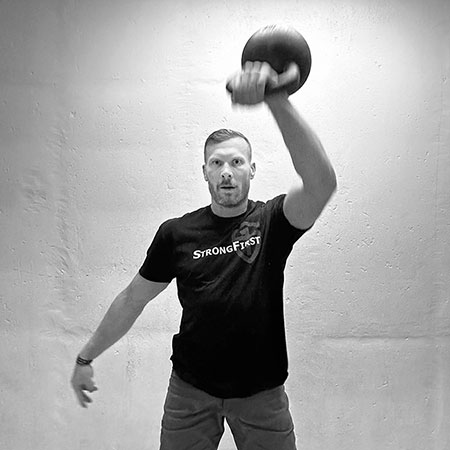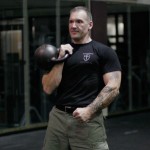How to perform the kettlebell snatch: start with a kettlebell on the ground in front of you, swing it back between your legs, and bring it into an overhead lockout position in one uninterrupted motion.
My Introduction to Snatching
Most people are introduced to kettlebells through swings and get-ups, and rightfully so. I, however, was introduced to kettlebells in 2008 with get-ups and snatches—talk about learning to run before learning to walk. My brother Ryan, now a StrongFirst Certified Senior Instructor, had been training with kettlebells and undergone a significant physical transformation. I was curious and asked him to write me a program utilizing kettlebells as the only tool. I had just come from running 400m hurdles at the USA World Team Trials and USA Olympic Team Trials for the past three seasons. In addition, weight training had been in my life since I was eight years old, I’d been Olympic lifting for the past decade, and was at the peak of my physical strength and power (or so I thought). But the snatch and the get-up were humbling, to say the least. It only took two sessions before I called him to ask that the program be modified. To his surprise, I couldn’t do a single get-up with 24kg, and I struggled to do ten snatches each hand on the minute (OTM) for more than three consecutive minutes.

After using kettlebells for a while, I began training for the RKC Kettlebell Instructor Certification. To pass I needed to perform thirty-six snatches in a row with each hand, using only one hand switch, and without setting the kettlebell down. This seemed like an incredibly daunting task, but I thoroughly enjoyed the athleticism of kettlebell movements and the efficiency of my training sessions (back then, I still called them workouts). Ryan reduced the snatching routine to 5L/5R OTM, and I was officially addicted to the task. After building this routine up to twenty minutes, I could complete the 36/36 snatches—barely. I felt like a weakling in the presence of former StrongFirst Certified Master Instructor Geoff Neupert, who allowed me to pass my first kettlebell certification.
The Secret Service Snatch Test
When I heard about the Secret Service Snatch Test (SSST), a ten-minute test for maximum repetitions using a 24kg or 16kg kettlebell for men and women respectively, I somehow thought it would be a great idea to try it. The benchmark for the SSST was at least 200 repetitions. Seven minutes into my first attempt I was cursing, sweating, and bleeding from torn callouses. Once my wounds healed, pride included, I went back to my 5L/5R OTM routine. Sometimes I added reps, either 6L/6R or 7L/7R, and even began giving larger kettlebells a try. Periodically, I would see how the 36/36 snatch test felt. After many weeks, 36/36 became fairly easy, and I thought the SSST was worth another shot. This time I made it the full ten minutes with 181 repetitions. I was excited, so I tried it again just two weeks later. I got exactly 181 again—dang it. I was disappointed realizing how hard it would be to squeeze out nineteen more repetitions. I was snatching “all out” for ten minutes straight and consistently felt exhausted by the seventh minute.
Then it dawned on me. Since I’d been training twenty-minute OTM sessions for so long, maybe I should approach the SSST this way. If I could do 10L/10R OTM and push myself for ten sets, then I’d reach 200. I could do twenty reps in about 45-50 seconds, so I would be able to relax for 10-15 seconds after each set. It took a lot of patience in minute nine to set the kettlebell down after 10L/10R, but I felt a surge of adrenaline during those ten seconds of rest. Having been an athlete, I knew I could push myself for one more minute. I completed twenty-three snatches in the final minute, hitting 203 reps right as time expired. Maybe it was silly to be so full of adrenaline in my basement by myself, but I was pumped. Before the adrenaline wore off and the Rocky theme song stopped playing in my mind, I decided that 10L/11R on odd minutes followed by 11L/10R on even minutes would be my ticket to 210.
I quickly flew past my 210-repetition goal, and I continued to train snatches OTM two to three days a week. Ryan and I went on to start a couple of kettlebell gyms called TNT. Of course, snatching was a staple in our training. Many of our students had top marks on the SSST record board (Tim Corbett, Melissa Schmidt, and Sandy Schneider to name a few), and my personal best had risen to 297 repetitions. While that seemed like a massive performance, it fell short of my 300-repetition goal. I needed time away from snatching, and as I’m sure you can relate, time slipped into never attempting it again. I sometimes reminisce about that test, contemplating whether my more experienced, now almost forty-two-year-old body, could outperform my twenty-eight-year-old self. Literally, hundreds of thousands of reps have made snatching as natural as walking to me. I’ve learned small tricks and nuances that came out of feeling the smoothness and flow of the kettlebell. One small nuance is imagining I’m Daniel-san from the Karate Kid, painting the fence.
Anyway, perhaps I’ll try the SSST again, but for now back to the story.
The proper path of the kettlebell snatch—clip from StrongFirst’s new course
Speed Metal: Master the Snatch, the Tsar of Kettlebell Lifts
The Tactical Strength Challenge
Eventually, we discovered the Tactical Strength Challenge (TSC), a competition involving a max weight deadlift, maximum pullup repetitions, and maximum snatching repetitions in five minutes. Our students flourished in this competition by mainly focusing on snatching in their training. Students like Melissa Schmidt, Jon Ehrhardt, Tim Corbett, Mike Wagner, Andrew Kuechler, Mary Dickerson, David Dallapiazza, Pat McClone, Steven Knuth, Chad Kollmann, Mark Clinton, and so many more that I’m forgetting had top three overall finishes. We were so snatch heavy, training it three days a week, that often we taught our students how to deadlift the morning of the TSC. Eventually, we decided deadlifting once a week in preparation might be a good idea, but still rarely practiced pullups. StrongFirst Certified Instructors Jackie and Ray Vazquez also caught the snatching “bug” from their TNT roots. They have since won multiple TSCs under The Gym WB, which is an awesome place that continues to carry the TSC tradition forward.
Side note: While snatching two to three days a week made us strong in deadlifts and pullups, I was personally never as good at pullups as StrongFirst Certified Senior Instructor Emeritus Tim Almond. Tim was a multi-time TSC champion and is a master at the kettlebell snatch. Tim has had a large influence on me, mostly in the form of motivation to beat him in the TSC. In all seriousness, I’d be remiss not to mention him while taking you through this story. Tim has had much to do with the evolution of snatching technique within our community, including the “Aussie Switch” and the deep palm grip.
Over the years TNT has sent many students to earn their StrongFirst kettlebell certifications. While most students consider the snatch test as the most daunting to pass, TNT folks are in their element during this test. With the tried-and-true 5L/5R OTM built up to twenty minutes+, paired with periodic intense efforts (timeless and glycolytic peaking), none of our students have had a difficult time passing the test. Karen Gasparick changed her life through the enjoyment of snatching when she broke the Guinness Book of World Records for most weight lifted by kettlebell snatch in one hour. Before getting into kettlebells, Karen not only avoided exercise but was afraid of it. She was intimidated by fit people, but decided she needed to change something as her health was declining at a young age. After a stint of bicycle riding, a friend convinced her to try a kettlebell class. Slowly, but surely, she became addicted to the movements. After a year of training, she decided to take on becoming a certified kettlebell instructor as a challenge. It didn’t come easy, but with dedicated training, she earned her title as an RKC kettlebell instructor and continued to refine her skills. Many years, and TSCs, later she decided that it was once again time to step out of her comfort zone and train for a challenge. This could be an entire article itself, so to make a long story much too short, in November of 2021 Karen snatched a 16kg kettlebell for an hour officially lifting 15,061.3kg. This broke the existing Guinness World Record at the time.
Speed Metal: Master the Snatch, the Tsar of Kettlebell Lifts
The Tsar of All Kettlebell Lifts
Kettlebell snatches have been called the “Tsar of all kettlebell lifts.” This idea has sunk deeply into my beliefs and snatches remain a staple in our training. Our TNT students are good at and interested in many things including wrestling, running, throwing, jiu-jitsu, rock climbing, obstacle course racing, the TSC, rucking, CrossFit competitions, and (of course) snatching. Personally, my goals and desires have changed, and I am more passionate about rock climbing and mountaineering than beating a snatch PR. But having seen so much transfer from snatching to other endeavors, I figure we might as well continue to use it to conquer other physical challenges and goals.
Methods used from Strong EnduranceTM seminar, The Quick and the Dead, and All-Terrain ConditioningTM seminar have helped me summit Aconcagua and Denali, South America and North America’s tallest peaks respectively. When three of my teammates gave up on Denali and their group gear was divided unequally among the strongest remaining, I was honored to carry the brunt of the weight. I believe it was the A+A snatch training that helped me continue the climb while carrying thirty kg at 5000m altitude. I also believe that ultra endurance can be built without endless hours of steady state cardio. Snatch walking for one hour on a routine basis gave me the endurance I needed to withstand twenty-four days on Denali with multiple consecutive eight to sixteen-hour days.
As the saying goes, “We won’t always attract what we want, but we’ll definitely attract what we are.” Today, Ryan, Kenneth Bolyard, and I use snatch training, from the courses and books mentioned, to prepare our everyday clients for the mountains. Our students have summited Aconcagua, Rainier, Grand Teton, Long’s Peak, Mt. Whitney, Mt. Lincoln, Mt. Democrat, Mt. Cameron, Mt. Bross, and more. In the most recent expedition to Grand Teton, thirteen of thirteen of our students achieved the summit. One of those students lost sixty-one pounds through the training process.
I’m so grateful to have learned how to snatch a kettlebell. I believe it will remain in my training routine for the rest of my life. And it makes me proud to be able to pass this information on through StrongFirst’s new course, Speed Metal: Master the Snatch, the Tsar of all Kettlebell Lifts. Here you will find up-to-date techniques that have been refined over the years, including many of the programs mentioned in this article and more. Check out this trailer and we’ll see you on the other side of awesome.
Check it out and we’ll see you on the other side of awesome









WiFi,
Yes, this is 5L and 5R on the minute.
Rick,
If you combo the snatch and step-up, I would follow the heart rate recommendations mentioned above / those in Strong Endurance or All-Terrain Conditioning. I haven’t played with snatch to step up long enough to really say much, but I have a hypothesis on it. With the snatch as a ballistic and the step-up as a grind, I think you’d have to switch hands often in order to keep the HR and burn at appropriate levels. This would slow the cadence of step-ups too much to be appropriately effective in improving hike performance, and I’m not sure it would help snatch performance either. I should be in elite condition by October (looking to climb El Cap with as little aiding as possible). I will personally try this combo in my peaking phase, and see how it goes.
Quick question on the notation – Does 5L/5R OTM mean 5L on minute one, and 5R on minute two? Or is it 5L, swing switch, 5R, each minute? I am currently training for the SSST, using 20 sets of 5 OTM, switching hands each minute.
Thanks!
Do you think a “Snatch Step-Up” variant of Snatch Walking is worth a try? Snatch, drop to the rack, step-up, reapeat.
How wrong could it be?
Derek, your SSST and other numbers leave me slack jawed!
I haven’t snatched much in recent years, but want to increase my uphill travel capability as it’s humiliating to have my brother who’s 9 years older leave me eating his snow dust on snowboard sidecountry missions. I find your snatch walking really intriguing and it got me thinking: could one combine snatching and box step-ups? Obviously, the box couldn’t be placed too close to the Girevik’s snatch area, but it seems like a lot of bang for the buck to rack the bell after lockout and do a few step-ups. Thoughts?
Thanks!
s.
Hmm, possibly interesting combo. Personally, I would snatch 1-2x a week and do a separate step up session 1-2x a week. If I combined the two, I would use the HR protocols that I use for step-ups which is either straight zone 2, OR high zone 3/low zone 4 during work down to low zone 2/high zone 1 during rest. Once again, there’s so much going on from snatches to step-ups, I’d likely keep them separate.
Derek … that was excellent!
Learned a lot. Anyone who snatches, regardless of experience, should climb on board and watch. Guarantee they will take home something.
Want to point out that despite this being titled “SPEED METAL” … your video allows the viewer to … S L O W it DOWN. Was able to watch some of the technique at .5 speed and it was helpful.
Keep on Climbing.
t – texas
Thank you Tom! A fellow climber? Please connect anytime!
-Derek
Hi Derek, love your story, and especially the product! Looking forward to run the plans. One question: How often should/could one add step ups (à la Kenneth Bolyard) or your “don’t put it down” sessions per week alongside the Snatch plans?
Hi Bauer,
There are many ways to go about your training schedule.
Personally, I snatch 2x a week, do step-ups once a week, carry day once a week, and have one day of pure strength work. With technical rock climbing 2-3 days a week, this fits my schedule perfectly.
I know Kenneth snatches or swings 3 days a week, and does step-ups 2 days a week. I believe he heads into the outdoors for a hill/mountain climb on weekends.
Thanks a lot, Derek!
Man, this is inspirational! I feel like I should get busy snatching.
💪🏻. Excellent. You will enjoy the results.